1. Global Burden of Disease Study 2013 Collaborators. Global, regional, and national incidence, prevalence, and years lived with disability for 301 acute and chronic diseases and injuries in 188 countries, 1990–2013: a systematic analysis for the Global Burden of Disease Study 2013. Lancet. 2015; 386(9995):743–800.
2. Food and Agriculture Organization of the United Nations. International Fund for Agricultural Development. UNICEF. World Food Programme. World Health Organization. The state of food security and nutrition in the world 2017: building resilience for peace and food security [Internet]. Rome: Food and Agriculture Organization of the United Nations;2017. cited 2019 Jul 1. Available from:
http://www.fao.org/3/a-I7695e.pdf.
3. Ministry of Health and Welfare, Korea Centers for Disease Control and Prevention. 2017 National health statistics. Cheongju: Ministry of Health and Welfare;2018.
4. Hruby A, Manson JE, Qi L, Malik VS, Rimm EB, Sun Q, et al. Determinants and consequences of obesity. Am J Public Health. 2016; 106(9):1656–1662.

5. Vartanian LR, Schwartz MB, Brownell KD. Effects of soft drink consumption on nutrition and health: a systematic review and meta-analysis. Am J Public Health. 2007; 97(4):667–675.

6. Kim YH. Status of beverage intakes in Korea, 1998–2012: Korea National Health and Nutrition Examination Survey (KNHANES). Public Health Wkly Rep. 2014; 7(7):133–140.
7. Balk L, Hoekstra T, Twisk J. Relationship between long-term coffee consumption and components of the metabolic syndrome: the Amsterdam Growth and Health Longitudinal Study. Eur J Epidemiol. 2009; 24(4):203–209.

8. Bouchard DR, Ross R, Janssen I. Coffee, tea and their additives: association with BMI and waist circumference. Obes Facts. 2010; 3(6):345–352.

9. Chiva-Blanch G, Badimon L. Effects of polyphenol intake on metabolic syndrome: current evidences from human trials. Oxid Med Cell Longev. 2017; 2017:5812401.

10. van Dam RM. Coffee consumption and risk of type 2 diabetes, cardiovascular diseases, and cancer. Appl Physiol Nutr Metab. 2008; 33(6):1269–1283.

11. Poole R, Kennedy OJ, Roderick P, Fallowfield JA, Hayes PC, Parkes J. Coffee consumption and health: umbrella review of meta-analyses of multiple health outcomes. BMJ. 2017; 359:j5024.

12. Grosso G, Marventano S, Galvano F, Pajak A, Mistretta A. Factors associated with metabolic syndrome in a Mediterranean population: role of caffeinated beverages. J Epidemiol. 2014; 24(4):327–333.

13. Grosso G, Stepaniak U, Micek A, Topor-Mądry R, Pikhart H, Szafraniec K, et al. Association of daily coffee and tea consumption and metabolic syndrome: results from the Polish arm of the HAPIEE study. Eur J Nutr. 2015; 54(7):1129–1137.

14. Takami H, Nakamoto M, Uemura H, Katsuura S, Yamaguchi M, Hiyoshi M, et al. Inverse correlation between coffee consumption and prevalence of metabolic syndrome: baseline survey of the Japan Multi-Institutional Collaborative Cohort (J-MICC) Study in Tokushima, Japan. J Epidemiol. 2013; 23(1):12–20.

15. Kim K, Kim K, Park SM. Association between the prevalence of metabolic syndrome and the level of coffee consumption among Korean women. PLoS One. 2016; 11(12):e0167007.

16. Kim Y, Je Y. Moderate coffee consumption is inversely associated with the metabolic syndrome in the Korean adult population. Br J Nutr. 2018; 120(11):1279–1287.

17. Kim HJ, Cho S, Jacobs DR Jr, Park K. Instant coffee consumption may be associated with higher risk of metabolic syndrome in Korean adults. Diabetes Res Clin Pract. 2014; 106(1):145–153.

18. Yeon JY, Bae YJ. 3-in-1 coffee consumption is associated with metabolic factors in adults: based on 2012 ~ 2015 Korea National Health and Nutrition Examination Survey. J Nutr Health. 2017; 50(3):257–269.
19. Cai L, Ma D, Zhang Y, Liu Z, Wang P. The effect of coffee consumption on serum lipids: a meta-analysis of randomized controlled trials. Eur J Clin Nutr. 2012; 66(8):872–877.

20. Panchal SK, Wong WY, Kauter K, Ward LC, Brown L. Caffeine attenuates metabolic syndrome in diet-induced obese rats. Nutrition. 2012; 28(10):1055–1062.

21. Hino A, Adachi H, Enomoto M, Furuki K, Shigetoh Y, Ohtsuka M, et al. Habitual coffee but not green tea consumption is inversely associated with metabolic syndrome: an epidemiological study in a general Japanese population. Diabetes Res Clin Pract. 2007; 76(3):383–389.
22. Song F, Oh JE, Lee KW, Cho MS. The effect of coffee consumption on food group intake, nutrient intake, and metabolic syndrome of Korean adults-2010 KNHANES (V-1). NFS J. 2016; 4:9–14.

23. Lee Y, Son J, Jang J, Park K. Coffee and metabolic syndrome: a systematic review and meta-analysis. J Nutr Health. 2016; 49(4):213–222.

25. Je Y, Jeong S, Park T. Coffee consumption patterns in Korean adults: the Korean National Health and Nutrition Examination Survey (2001–2011). Asia Pac J Clin Nutr. 2014; 23(4):691–702.
28. Ministry of Health and Welfare, Korea Centers for Disease Control and Prevention. Korea Health Statistics 2015: Korea National Health and Nutrition Examination Survey (KNHANES VI-3). Cheongju: Korea Centers for Disease Control and Prevention;2016.
29. Ministry of Health and Welfare, Korea Centers for Disease Control and Prevention. Korea Health Statistics 2016: Korea National Health and Nutrition Examination Survey (KNHANES VII-1). Cheongju: Korea Centers for Disease Control and Prevention;2017.
31. Kim TH, Chae SJ, Kim CW. A study on the coffee consumption behavior by lifestyle. Korean J Hosp Adm. 2013; 22(2):93–112.
32. Kim SH. Coffee consumption behaviors, dietary habits, and dietary nutrient intakes according to coffee intake amount among university student. J Nutr Health. 2017; 50(3):270–283.
33. Lee S, Cho W, Cho N, Shin C. The association between coffee consumption and all-cause mortality according to sleep-related disorders. Korean J Community Nutr. 2015; 20(4):301–309.

34. Lee J, Kim HY, Kim J. Coffee consumption and the risk of obesity in Korean women. Nutrients. 2017; 9(12):1340–1352.

35. Shin H, Linton JA, Kwon Y, Jung Y, Oh B, Oh S. Relationship between coffee consumption and metabolic syndrome in Korean adults: data from the 2013–2014 Korea National Health and Nutrition Examination Survey. Korean J Fam Med. 2017; 38(6):346–351.

36. Kim JH, Park YS. Light coffee consumption is protective against sarcopenia, but frequent coffee consumption is associated with obesity in Korean adults. Nutr Res. 2017; 41:97–102.

37. Wang T, Huang T, Kang JH, Zheng Y, Jensen MK, Wiggs JL, et al. Habitual coffee consumption and genetic predisposition to obesity: gene-diet interaction analyses in three US prospective studies. BMC Med. 2017; 15(1):97.

39. Lee B, Lee HJ, Cho E, Hwang KT. Fatty acid composition of fats in commercial coffee creamers and instant coffee mixes and their sensory characteristics. J Korean Soc Food Sci Nutr. 2012; 41(3):362–368.
40. Korea Health Industry Development Institute (KHIDH). Sugar database compilation for commonly consumed foods. Cheongju: Korea Health Industry Development Institute;2015.
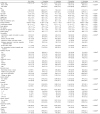
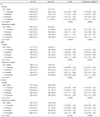
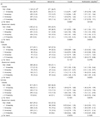
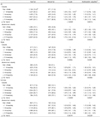




 PDF
PDF ePub
ePub Citation
Citation Print
Print



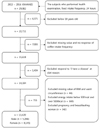
 XML Download
XML Download